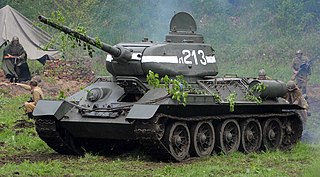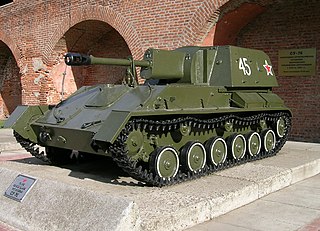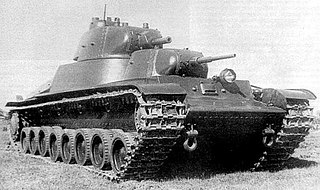Related Research Articles

The T-34 is a Soviet medium tank from World War II. When introduced, its 76.2 mm (3 in) tank gun was more powerful than its contemporaries, and its 60-degree sloped armour provided good protection against anti-tank weapons. The T-34 had a profound effect on the conflict on the Eastern Front, and had a long-lasting impact on tank design. The tank was praised by multiple German generals when encountered during Operation Barbarossa, although its armour and armament were surpassed later in the war. Though, its main strength was its cost and production time, meaning that German panzer forces would often fight against Soviet tank forces several times their size. The T-34 is also a critical part of the mechanized divisions that form the backbone of the Deep Battle Strategy.

The IS tanks were a series of heavy tanks developed as a successor to the KV-series by the Soviet Union during World War II. The IS acronym is the anglicized initialism of Joseph Stalin. The heavy tanks were designed as a response to the capture of a German Tiger I in 1943. They were mainly designed as breakthrough tanks, firing a heavy high-explosive shell that was useful against entrenchments and bunkers. The IS-2 went into service in April 1944 and was used as a spearhead by the Red Army in the final stage of the Battle of Berlin. The IS-3 served on the Chinese-Soviet border, the Hungarian Revolution, the Prague Spring and on both sides of the Six-Day War. The series eventually culminated in the T-10 heavy tank.

The Kliment Voroshilov (KV) tanks are a series of Soviet heavy tanks named after the Soviet defence commissar and politician Kliment Voroshilov who operated with the Red Army during World War II. The KV tanks were known for their heavy armour protection during the early stages of the war, especially during the first year of the German invasion of the Soviet Union. In certain situations, even a single KV-1 or KV-2 supported by infantry could halt German formations. The German Wehrmacht at that time rarely deployed its tanks against KVs, as their own armament was too poor to deal with the "Russischer Koloss" – "Russian Colossus".

The T-26 tank was a Soviet light tank used during many conflicts of the Interwar period and in World War II. It was a development of the British Vickers 6-Ton tank and was one of the most successful tank designs of the 1930s until its light armour became vulnerable to newer anti-tank guns. It was produced in greater numbers than any other tank of the period, with more than 11,000 units manufactured giving it the title of the most produced tank during the interwar period. During the 1930s, the USSR developed 53 variants of the T-26, including flame-throwing tanks, combat engineer vehicles, remotely controlled tanks, self-propelled guns, artillery tractors, and armoured carriers. Twenty-three of these were series-produced, others were experimental models.

The T-35 was a Soviet multi-turreted heavy tank of the interwar period and early Second World War that saw limited production and service with the Red Army. Often called a land battleship, it was the only five-turreted heavy tank in the world to reach production, but proved to be slow and mechanically unreliable. Most of the T-35 tanks still operational at the time of Operation Barbarossa were lost due to mechanical failure rather than enemy action. It was designed to complement the contemporary T-28 medium tank; however, very few were built.

The BT tanks were a series of Soviet light tanks produced in large numbers between 1932 and 1941. They were lightly armoured, but reasonably well-armed for their time, and had the best mobility of all contemporary tanks. The BT tanks were known by the nickname Betka from the acronym, or its diminutive Betushka. The successor of the BT tanks was the famous T-34 medium tank, introduced in 1940, which would replace all of the Soviet fast tanks, infantry tanks, and medium tanks in service.

The SU-76 was a Soviet light self-propelled gun used during and after World War II. The SU-76 was based on a lengthened version of the T-70 light tank chassis and armed with the ZIS-3 mod. 1942 76-mm divisional field gun. Developed under the leadership of chief designer S.A. Ginzburg (1900–1943). Its quite simple construction and multipurpose combat role made it the second most produced Soviet armored fighting vehicle of World War II, after the T-34 medium tank.

The SU-152 is a Soviet self-propelled heavy howitzer used during World War II.

The T-70 is a light tank used by the Red Army during World War II, replacing both the T-60 scout tank for reconnaissance and the T-50 light infantry tank for infantry support. The T-80 light tank was a more advanced version of the T-70 with a two-man turret—it was produced only in very small numbers when light tank production was abandoned. The T-90 self-propelled anti-aircraft gun was a prototype vehicle with twin machine guns, based on the T-70 chassis.

The T-50 was a light infantry tank built by the Soviet Union at the beginning of World War II. The design for this vehicle had some advanced features, but was complicated and expensive, and only a short production run of 69 tanks was completed.

The 76 mm tank gun M1940 F-34 was a 76.2 mm Soviet tank gun used on the T-34/76 tank. A modified version of the gun, the 76 mm tank gun M1941 ZiS-5, was used on KV-1 tanks during World War II. Nowadays, the two versions are often referred to just by their factory designations, as "F-34" and "ZiS-5", respectively.

The T-43 medium tank was a prototype Soviet medium tank developed during the Second World War as a possible replacement for both the T-34 medium and KV-1 heavy tanks. The project's aim was to build a medium tank with heavier armour, but German advances in tank technology proved better countered by a more heavily armed T-34-85 and the T-43 was cancelled.

The SU-100Y was a Soviet prototype self-propelled gun, developed from the prototype T-100 tank. It was developed during the Winter War with Finland to include a 130 mm gun to destroy concrete defensive structures like bunkers and anti-tank obstacles along with the use as a tank destroyer. It did not see production, but the prototype was brought into use in the Second World War in defence of Moscow and possibly in other operations as it stayed in service until the end of the war.

The T-100 was a Soviet twin-turreted heavy tank prototype, designed in 1938–39 as a possible replacement for the T-35 heavy tank. The T-100 was designed by N. Barykov's OKMO design team at S.M. Kirov Factory No. 185 in Leningrad. The T-100 was originally conceived with three turrets and was eventually built with two. It was in competition with a similar design - the SMK - but neither were adopted and instead a single turret version of the SMK was ordered as the KV-1. All three prototypes were tested at the same time in the Battle of Summa during the Winter War with Finland.
Obukhov State Plant is a major Russian metallurgy and heavy machine-building plant in St. Petersburg, Russia.

The SMK was an armored vehicle prototype developed by the Soviet Union prior to the Second World War. It was named after Sergei Mironovich Kirov, a Communist Party official assassinated in 1934. The SMK was discovered and classified by German intelligence as the T-35C, leading to the misunderstanding that the T-35 took part in the Winter War.

More than 50 different modifications and experimental vehicles based on the T-26 light infantry tank chassis were developed in the USSR in the 1930s, with 23 modifications going into series production. The majority were armoured combat vehicles: flame tanks, artillery tractors, radio-controlled tanks (teletanks), military engineering vehicles, self-propelled guns and armoured personnel carriers. They were developed at the Leningrad Factory of Experimental Mechanical Engineering by talented Soviet engineers P.N. Syachentov, S.A. Ginzburg, L.S. Troyanov, N.V. Tseits, B.A. Andryhevich, M.P. Zigel and others. Many Soviet tank engineers were declared "enemies of the nation" and repressed during Stalin's Great Purge from the middle of the 1930s. As a result, work on self-propelled guns and armoured carriers ceased in the USSR during that time. T-26 light tanks were also modified into armoured combat vehicles in the field during wartime.
The KV-4 was a proposed Soviet heavy break-through tank, developed during World War II as a part of the Kliment Voroshilov tank design series.

The IS-2 is a Soviet heavy tank, the first of the IS tank series named after the Soviet leader Joseph Stalin. It was developed and saw combat during World War II and saw service in other Soviet allied countries after the war.

The Object 770, was a prototype Soviet heavy tank designed in 1956, and was one of the last heavy tanks ever produced. It was developed alongside the Object 277 and the Object 279 following the Decree of the Council of Ministers of the USSR on August 12, 1955. Development was cancelled in 1960 following Nikita Khrushchev's orders to stop production of all heavy tanks weighing over 37 tons.
References
- 1 2 3 4 Magnuski, Janusz (1997). Ciężki czołg KW (in Polish). Warszawa: Pelta. pp. 5, 56–57. ISBN 83-85314-12-1.
W lutym 1933 produkcję czołgów w "Bolszewiku" zakończono i przeniesiono do wyodrębnionej z tych zakładów smodzielnej Fabryki nr 174 im. K. Woroszyłowa. Równocześnie AWO-5 zreorganizowano i nazwano OKMO [...]. Kilka miesięcy później i OKMO usamodzielniono, przekształcając ten oddział w Fabrykę nr 185 im. S. M. Kirowa.
- 1 2 Official website, History of Obukhov Plant Archived 2012-03-05 at the Wayback Machine
- ↑ Sewell, Stephen 'Cookie' (1998). “Why Three Tanks?” Archived 2016-03-04 at the Wayback Machine (PDF) in Armor vol. 108, no. 4, p. 21. Fort Knox, KY: US Army Armor Center. ISSN 0004-2420.
- ↑ Zaloga says that in 1935, after the assassination of Sergey Kirov, the whole Bolshevik Factory No. 232 was renamed "Factory No. 185 (S.M. Kirov)", yet Leningrad inhabitants continued to refer to it as the Bolshevik Factory: Zaloga, Steven J., James Grandsen (1984). Soviet Tanks and Combat Vehicles of World War Two, p. 53, London: Arms and Armour Press. ISBN 0-85368-606-8.